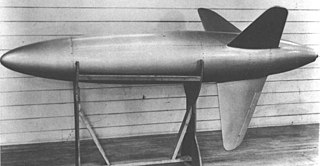
The Gorgon missile family was a series of experimental air-to-air, air-to-surface, and surface-to-surface missiles developed by the United States Navy's Naval Aircraft Modification Unit between 1943 and 1953. The immaturity of the technology involved meant that none of the Gorgon missiles achieved operational service, however they were extensively used in the development of guided missile controls and guidance technologies.

The VB-6 Felix was a precision-guided munition developed by the United States during World War II.

The LBD-1 Gargoyle was an American air-to-surface missile developed during World War II by McDonnell Aircraft for the United States Navy. One of the precursors of modern anti-ship missiles, it was extensively used as a test vehicle during the late 1940s.

The Bold Orion missile, also known as Weapons System 199B (WS-199B), was a prototype air-launched ballistic missile (ALBM) developed by Martin Aircraft during the 1950s. Developed in both one- and two-stage designs, the missile was moderately successful in testing, and helped pave the way for development of the GAM-87 Skybolt ALBM. In addition, the Bold Orion was used in early anti-satellite weapons testing, performing the first interception of a satellite by a missile.

The JB-4, also known as MX-607, was an early American air-to-surface missile developed by the United States Army Air Forces during World War II. Using television/radio-command guidance, the JB-4 reached the flight-testing stage before being cancelled at the end of the war.

The Radioplane XKD4R, known by the company designation RP-70, was an American target drone developed by the Radioplane Division of the Northrop Corporation. Although it was not produced in quantity, it was developed into the successful AQM-38.
The Cherokee was an experimental rocket built by the Cook Electric Co. for use by the United States Air Force during the 1950s for the testing of ejection seats.
The Anti-Aircraft Target Rocket M2 was a 3.25-inch (83 mm) rocket developed and used by the United States Army during World War II. It was designed to serve as a training target for anti-aircraft guns, capable of simulating attacks by low-flying aircraft. The nosecone of the rocket was ogival, and it was fitted with oversized fins to aid in tracking of the rocket by trainees.

The PTV-N-2 Gorgon IV was a ramjet-powered missile developed by the Glenn L. Martin Company for the United States Navy. Originally intended as an air-to-surface weapon, it materialized as a propulsion test vehicle, and between 1947 and 1950 was used for test purposes and, as the KDM Plover, as a target drone.

The CTV-N-2 Gorgon IIC – also designated KGN, KUN, and CTV-2 – was an experimental drone, originally intended as a surface-to-surface missile, developed by the United States Navy near the end of World War II. It was used to test control and homing systems for guided missiles, and was also produced in small numbers as a target drone under the designations TD3N and KD2N.

The KA2N Gorgon IIA – also designated KU2N, CTV-4, and CTV-N-4 – was an air-to-air missile developed by the United States Navy near the end of World War II. Proving a failure in its designed role, it was repurposed as an experimental testbed for missile technology.

The Gorgon III – given the military designations KA3N, KU3N, CTV-N-6 and RTV-N-4 – was a rocket-powered air-to-air missile developed by the United States Navy near the end of World War II. With the end of the war, the program was changed to that of a research vehicle for missile control systems; both single and twin-rocket-powered versions were built and tested.

The XSSM-A-23 Dart was an anti-tank guided missile developed for the United States Army in the 1950s. After protracted development, the missile, similar in design to the French SS.10, was cancelled in favor of purchasing the SS.11 missile.

Jaguar was a three-stage sounding rocket developed by the United States Air Force in the early 1960s. Designed for air launch to allow soundings from remote areas without infrastructure, it was only launched twice before the project was abandoned.

The Republic SD-3 Snooper was an early reconnaissance drone developed by Republic Aviation for the United States Army. It was evaluated by the Army Signal Corps in 1959, but did not enter operational service.
The Republic SD-4 Swallow was an early high-speed reconnaissance drone developed by Republic Aviation for the United States Army. Intended for use by the U.S. Army Signal Corps to target tactical ballistic missiles, it was cancelled before the first prototype could be completed, and did not see operational service.

The Fairchild SD-5 Osprey was an early high-speed reconnaissance drone developed by Fairchild Aircraft for the United States Army. Intended for use by the U.S. Army Signal Corps to target tactical ballistic missiles, it was cancelled before the first prototype could be completed, and did not see operational service.
The Aviolanda AT-21 was a target drone developed in the Netherlands by Aviolanda. Powered by a pulsejet engine, it was the Netherlands' first drone to be successfully developed, and saw limited use in the late 1950s and early 1960s.

The JB-3 Tiamat, also designated MX-570, was an early air-to-air missile developed by Hughes Aircraft for the United States Army Air Forces during World War II. Regarded as a purely experimental vehicle, test launches took place for several years before the program was terminated.

The TDU-12/B Skydart was an unguided target rocket built by Curtiss-Wright for use by the United States Air Force. It was used operationally from the late 1950s to the mid 1960s.

























